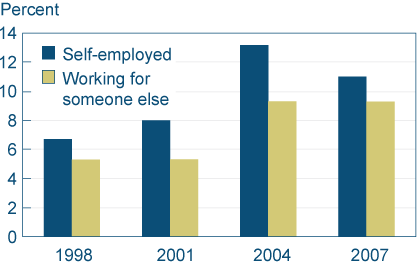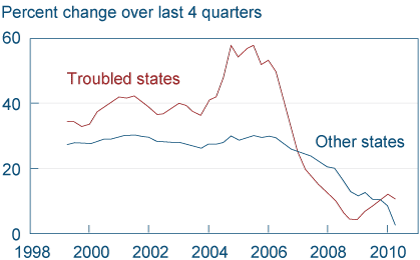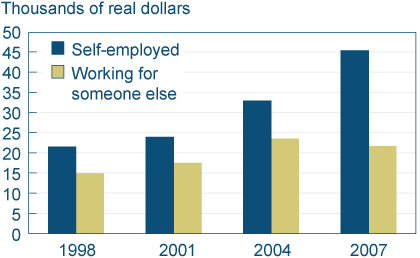- Share
The Effect of Falling Home Prices on Small Business Borrowing
Small businesses continue to report problems obtaining the financing they need. Because small business owners may rely heavily on the value of their homes to finance their businesses (through mortgages or home equity lines), the fall in housing prices might be one of the causes of their difficulty. We analyze information from a variety of sources and find that homes do constitute an important source of capital for small business owners and that the impact of the recent decline in housing prices is significant enough to be a real constraint on small business finances.
The views authors express in Economic Commentary are theirs and not necessarily those of the Federal Reserve Bank of Cleveland or the Board of Governors of the Federal Reserve System. The series editor is Tasia Hane. This paper and its data are subject to revision; please visit clevelandfed.org for updates.
A persistent issue throughout the recovery has been the reported inability of small businesses to get the financing that they need. To better understand the sources of any shortfall, the Federal Reserve System undertook a project in 2010 to meet with representatives from banks and small businesses.1 In some of the focus groups convened by the Federal Reserve this summer, participating small business owners explained that the reduced value of their homes has made it difficult for them to provide the necessary collateral for small business loans. Other participants said that the reduced value of homes has made home equity borrowing as a source of business capital more difficult to come by, also contributing to the difficulty many small businesses face in obtaining sufficient capital to finance their operations. While the small business owners’ message of a link between home values and small business borrowing came through loud and clear in the focus groups, the process did not provide estimates on the magnitude of the effect of declining home values on small businesses’ access to capital.
Data sources on the full range of small business finance options are rare, and they often cover only a portion of small businesses. In part, this is because small businesses are by nature highly heterogeneous, ranging from relatively large and financially sophisticated car dealerships to single-person start-ups structured as sole proprietorships. Despite this variation, the focus groups revealed financial challenges for both the largest and smallest of small businesses.
This Commentary analyzes information from a variety of sources in order to quantify the connection between home values and small businesses’ access to capital. Specifically, we examine the extent to which small business owners use their homes to finance their businesses, the rise in the use of homes as a source of capital for small businesses during the housing boom, the magnitude of the effect of housing price declines on small business finance, and the variation in these issues across states, industries, and types of small businesses. Our analysis reveals that the magnitude of the effect of home prices on small business finances is large enough to be a real constraint on growth but the degree to which home price declines are hindering the growth of small businesses is difficult to fully quantify. Differences across the data sources and the heterogeneity of small businesses continue to limit what we can determine.
Do Small Business Owners Use Residential Mortgages to Finance Their Businesses?
Small businesses owners often report using residential real estate to obtain capital for their businesses. One set of estimates on the extent of such financing comes from a 2009 Gallup survey of small business owners funded by the National Federation of Independent Businesses (NFIB). The sample was designed to be representative of all firms with fewer than 500 employees, the Small Business Administration’s definition of a small business. Approximately 16 percent of those surveyed reported that they borrow against the value of their homes for business purposes, and 7 percent said that they put up their homes as collateral for business purposes. These numbers rise to 20 percent and 11 percent, respectively, if one includes residential real estate other than the owner’s primary residence.
Other sources have even higher estimates. Barlow Research runs a quarterly survey of small business owners, which asks them about all of their banking relationships. This survey samples larger small businesses and focuses on firms that are listed in Dun and Bradstreet and have sales between $100,000 and $10,000,000. The sample is weighted based on population counts in four regions (the Midwest, Northeast, South, and West) and five sales volumes ($100,000–$499,000, $500,000–$999,000, $1,000,000–$2,490,000, $2,500,000–$4,990,000, and $5,000,000–$9,900,000).
In the 2007 Barlow surveys, 20.5 percent of the business owners reported pledging their homes as collateral for their businesses and 18.2 percent said they borrowed against their homes to obtain a personal loan where the proceeds were used to finance a small business. Taken together, the Barlow data show that, in 2007, 25.4 percent of small business owners used the equity in their homes to finance their businesses in at least one of these two ways.
These data sources show that a substantial number of small business owners borrow against their homes to finance their businesses. Consequently, they suggest that home borrowing constraints would affect small business finance. However, the data do not reveal how large the effect of those constraints might be.
Are Small Business Owners Significant Users of Home Equity Lines of Credit?
Another way small business owners can leverage their personal wealth to finance their companies is with home equity lines of credit. This type of funding is difficult to assess from data sets focused on the businesses, but the Federal Reserve’s Board of Governors conducts a detailed Survey of Consumer Finances (SCF) every three years, and it reports some relevant data. This survey is designed to be representative of all U.S. households, including those headed by small business owners, and it is focused on the households’ finances rather than business borrowing. Nonetheless, the survey reveals important patterns in the borrowing activities of small business owners.
Figure 1. Percent of Households with Home Equity Debt

Source: Board of Governors of the Federal Reserve System, Survey of Consumer Finances; authors' calculations.
As figure 1 shows, SCF households headed by a self-employed person are more likely to have a home equity line of credit than households headed by a person who works for someone else. Similarly, an analysis of SCF responses by Brian Bucks, Arthur Kennickell, Traci Mach, and Kevin Moore shows that in 2007, 20.4 percent of households headed by a self-employed person had a home equity line of credit compared to 12.6 percent of households overall. Of those with credit lines, 11.0 percent of the self-employed households had drawn upon them, while 8.5 percent of all households had.2
These figures suggest that business ownership increases the use of home equity lines of credit. This pattern could just reflect differences in the relative wealth or income patterns between households led by business owners and non-owners. For example, business-owning households might need to borrow money just to smooth their more variable incomes, not to finance the business per se. In order to account for these differences, we conducted a regression analysis to predict the use of home equity lines of credit as a function of being a business owning or non-business owning household, controlling for the head of household’s age, race, marital status, income, and non-home assets and the year of investigation, using data from the Survey of Consumer Finances for 1998, 2001, 2004, and 2007. We found that people owning businesses who took out home equity loans borrowed a higher percentage of the value of their homes than people who didn’t own businesses. This doesn’t directly connect home equity lines to businesses, but it provides evidence of the potential scale of home equity borrowing for business purposes that the focus groups revealed.
Did Home Equity Borrowing by Businesses Expand During the Housing Boom?
If small businesses rely on their housing wealth to finance their companies, we might expect their home equity borrowing to increase during periods when housing prices rise, such as we saw during the recent boom. To help us answer this question, we looked at data from the FFIEC Call Reports. Call Reports are the source of the most commonly reported data on small business lending, although they provide information only on small loans (less than $1 million) to businesses.
Call Report data show that the amount of both outstanding small loans to businesses and home equity borrowing increased dramatically from 2000 to 2007.3 Some small loans to businesses may have been secured by the owner’s real estate, but the Call Report does not provide any information on the collateral used. Still, based on the frequency with which our focus groups discussed this type of lending, we can assume that some of the increase in the amount of small loans to businesses during the housing boom likely represents an increase in business loans collateralized by the business owner’s home equity.
Figure 2. The Median Value of Home Equity Debt

Source: Board of Governors of the Federal Reserve System, Survey of Consumer Finances; authors' calculations.
A more direct source of data on small business borrowing is again derived from the Federal Reserve’s Survey of Consumer Finances. It shows that from 1998-2007, small-business-owning households took on larger amounts of home equity debt faster than households headed by someone employed by others. As figure 2 shows, between 1998 and 2007, the home equity debt of households headed by the self-employed rose 110 percent while that of households led by those employed by others grew only 46 percent.
These data show that not only were small-business-owning households greater users of home equity lines of credit than non-business-owning households in 1998 (prior to the housing boom), their home equity borrowing also accelerated more during the period where house prices rose sharply.
How Are Home Price Declines Likely to Affect Small Business Borrowing?
Given the evidence that small business owners use home equity as a source of financing for their businesses, one would expect the recent decline in home prices to have adversely affected small business borrowing.
In fact, this negative effect has been reported in several surveys of small business owners. For instance, a survey conducted by the Federal Reserve Bank of Atlanta in April 2010 found that 15 percent of firms cited lack of equity in business or personal real estate as an obstacle to accessing credit for their businesses. In addition, participants in the Federal Reserve’s focus groups this summer reported that as housing prices fell, business owners whose business debt was linked to residential real estate had faced demands for more collateral by lenders.
While we have no data on the effect of home prices on home equity borrowing for the purpose of financing a business, we can estimate this effect by looking at the effect of changes in home prices on the amount of home equity loans in force. We just need to assume that home equity loans used for business purposes respond to home prices in a similar way as home equity loans for other purposes. The data we use for our estimates are provided in the Federal Reserve Bank of New York Consumer Credit Panel.
The overall amount of home equity lending that has been extended is highly correlated with home prices, but the figures are complicated by the unknown extent to which funds have been drawn from available credit lines. For example, a $100,000 credit line that may have existed for years may have only been tapped during the economic downturn.. That use of the credit line would show up in the data, but it could be misinterpreted as evidence that banks were willingly extending more credit after the slowdown. It would look as if credit had expanded, but lenders might have preferred to lower the amount of credit available to individuals due to lower housing prices. However, outstanding loans and credit lines are harder for banks to unilaterally adjust. With this caution recognized, we examined the outstanding levels of home equity borrowing.
It is clear that as housing prices across the nation increased during the boom, so did the amount people borrowed through home equity lines; and when housing prices began to decline, the growth in home equity line borrowing slowed in many states and came to a halt in others. It is worth noting that the overall increase in home equity borrowing was immense, having grown at rates in excess of 40 percent a year in many states.
What is not clear is how much of the change in borrowing was due to changing home values, and how much to the general growth of this form of lending. To examine that relationship, we conducted regression analyses, looking at changes in home prices and changes in the amount of home equity loans outstanding across the U.S. Regression analysis allows us to identify how much more home equity borrowing was rising in states where homes were appreciating in value rapidly than in states where home values were rising more slowly, and then how quickly home equity borrowing declined when housing prices tumbled. Note that this analysis is based on drawn credit rather than the amount potentially available to borrow, so it includes the additional use of existing credit lines during the recession. Our regressions reveal both a statistically reliable relationships across states in home price appreciation and price declines and the amount of home equity borrowing outstanding in a state.
Figure 3 shows the predicted rate of change in home equity lending as a function of home prices. Because the states with the greatest home price declines might have a different relationship between home prices and home equity borrowing than other states, we examine the two sets of states separately. The relationship between housing prices and the amount of home equity loans was present for all states. The main difference between the states with the greatest home price declines (troubled states) and the less troubled states was that home equity loans were actually more sensitive to home price declines in the more troubled states. It is worth noting that actual credit growth in the most recent quarters has deteriorated more rapidly than this model predicts. Nonetheless, the model clearly reveals the strong connection between home prices and home equity credit since the late 1990s. Recent price declines in house prices would be expected to further lower the level of home equity borrowing.
Figure 3. Predicted Growth of Home Equity Lines of Credit

Source: Federal Reserve Bank of New York, Consumer Credit Panel; authors' calculations.
Since the decline in home prices began, the U.S. has seen a decline of $31.5 billion in home equity lines of credit, compared to several years of rapid growth prior to the downturn. Our regression model would treat some of this decline in borrowing as idiosyncratic variation not connected with declining home prices, but the decline is still potentially impacting business owners’ access to credit. From the Barlow survey data, we found that approximately 18.2 percent of small business owners borrowed personally against the equity in their homes to finance their businesses. Calculations from the Survey of Consumer Finances reveal that business owners accounted for 25.1 percent of home equity borrowing in 2007. The exact rate at which business owners fund their businesses from equity is not identifiable from either source, because the amount used for business purposes is not reported. However, if one assumes the 2007 share of home equity borrowing used by business owners has remained constant, the $31.5 billion decline in home equity lines of credit would eliminate $7.9 billion in credit available to business owners for either personal use or business operations. [Note: the original calculations in this paragraph were modified on 12/24/2010 to correct an error.]
The $7.9 billion drop in home equity lending available to businesses is still relatively small when you consider that, in the 2000 to 2008 time period, balances on home equity lines rose more than $66 billion a year, according to the Federal Reserve Bank of New York’s Consumer Credit Panell. This rapid growth in home equity borrowing was a significant source of new credit, but since the first quarter of 2009, growth has slowed considerably. With no growth in the aggregate level of credit, it is feasible that no new credit is made available, as existing borrowers simply hold their balances constant. We don’t think that extreme is relevant, but the reduced credit growth does leave substantially less room for new credit draws or originations. If small businesses received about 25.1 percent of new home equity borrowing, the slower growth in home equity borrowing would imply a reduction in new small business credit of more than $16.5 billion. Together with the decline in home equity lending, small business credit is $24.5 billion below where it would have been had the trend in home equity lending continued. [Note: the figures in this paragraph were also updated on 12/24/2010.]
We compare this amount to the Community Reinvestment Act data on loan originations to businesses with less than $1 million of revenue. (These firms almost certainly would meet the SBA standard of a small business—less than 500 employees—and almost all firms with less than 500 employees have revenues less than $1 million.) In 2009, loans to firms of this revenue size were $71.8 billion*, down more than 30 percent from 2008.4 The effect of shrinking home equity borrowing on overall small business finance is likely smaller than this change but still quite substantial. [*this number was changed from 70.1 on 1/5/2010.]
Conclusion
Everyone agrees that small business borrowing declined during the recession and has not yet returned to pre-recession levels. Lesser consensus exists around the cause of the decline. Decreased demand for credit, declining creditworthiness of small business borrowers, an unwillingness of banks to lend money to small businesses, and tightened regulatory standards on bank loans have all been offered as explanations.
While we would agree that these factors have had an effect on the decline in small business borrowing through commercial lending, we believe that other limits on the credit of small business borrowers are also at play and could be harder to offset. Specifically, the decline in home values has constrained the ability of small business owners to obtain the credit they need to finance their businesses.
Of course, not all small businesses have been equally affected by the decline in home prices. While many small business owners use residential real estate to finance businesses, not all do. Those more likely do so to include companies in the real estate and construction industries, those located in the states with the largest increases in home prices during the boom, younger and smaller businesses, companies with lesser financial prospects, and those not planning to borrow from banks. These patterns are also evident in the data sources we examined.
The link between home prices and small business credit poses important challenges for policy makers seeking to improve small business owners’ access to credit. The solution is far more complicated than telling bankers to lend more or reducing the regulatory constraints that may have caused them to cut back on their lending to small companies. Returning small business owners to pre-recession levels of credit access will require an increase in home prices or a weaning of small business owners from the use of home equity as a source of financing. Neither of those alternatives falls into the category of easy and quick solutions.
References
- “Restoring the Flow of Credit to Small Businesses,” Ben Bernanke. 2010. Speech at the Federal Reserve Meeting Series, “Addressing the Financing Needs of Small Businesses,” Washington, D.C. (July 12). Available at http://www.federalreserve.gov/newsevents/speech/bernanke20100712a.htm.
- “Changes in U.S. Family Finances from 2004 to 2007: Evidence from the Survey of Consumer Finances,” by Brian K. Bucks, Arthur B. Kennickell, Traci L. Mach, and Kevin B. Moore. 2009. Federal Reserve Bulletin, 92 (February): A1–A38.
- Federal Financial Institutions Examination Council (FFIEC) Call Report data are available at https://www.ffiec.gov/cra/.
- All institutions regulated by the Federal Reserve, the Office of the Comptroller of the Currency, the FDIC, or the Office of Thrift Supervision and whose assets are greater than $1.109 billion for the two years preceding December 31 of a given year are required to report their small business lending under the Community Reinvestment Act (CRA). National aggregate tables are available on the FFIEC website at http://www.ffiec.gov/craadweb/national.aspx.
This work by Federal Reserve Bank of Cleveland is licensed under Creative Commons Attribution-NonCommercial 4.0 International





